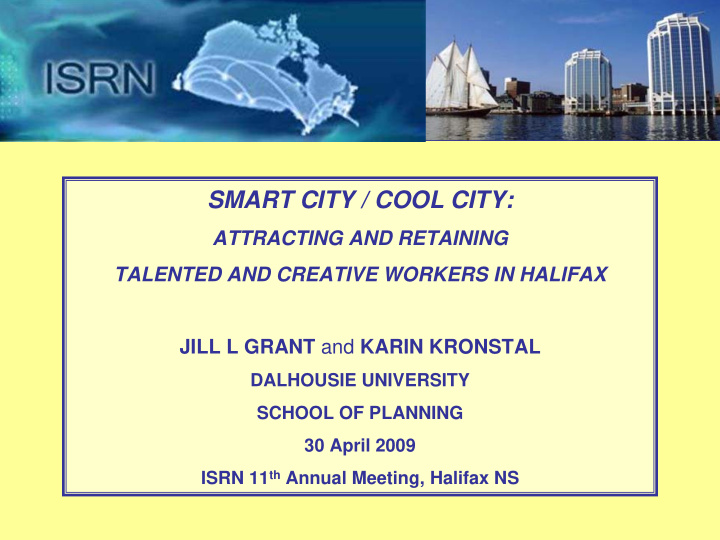



SMART CITY / COOL CITY: ATTRACTING AND RETAINING TALENTED AND CREATIVE WORKERS IN HALIFAX JILL L GRANT and KARIN KRONSTAL DALHOUSIE UNIVERSITY SCHOOL OF PLANNING 30 April 2009 ISRN 11 th Annual Meeting, Halifax NS
Background: Halifax Regional Municipality created in 1996: area the size of Prince Edward Island; population 372,000 Economy driven by government, military, health care, education, port activities, tourism Six universities: attracting students from across Canada http://www.writers.ns.ca/Writers/awalker.html
From disadvantaged to “interesting”: In the 1990s Halifax’s economy and reputation changed Unemployment declined, tourism increased, university enrolments climbed Government investment in waterfront and other improvements Halifax seen as a “cool city”; indie music scene
Census information indicates that Halifax has a higher proportion of creative workers in its workforce than Canada as a whole 2001 2006 Halifax 37.4% 38.0% Canada 29.2% 33.2% People migrate to Halifax from other provinces [middle band in graphs]. The rate of in-migration of creative workers as a proportion of total workers is decreasing. 20% Source: G Spencer and T Vinodrai. Halifax. ISRN profiles, 2006, 2009
What factors affect the ability of Halifax to attract and retain talented and creative workers? We profiled three sectors: health research, music, and built environment consulting In 2008 we conducted 26 interviews with 28 individuals: •16 male, 12 female •13 creative workers, 7 employer/supervisors, 8 intermediary organisation reps
Common factors across sectors: Beautiful natural setting, access to nature Quality of life in the city: affordability, ease of commuting Size of the city: “just right” Vibrant arts and culture; night life and music scene Good international connections Cluster of universities
Social factors attracting people to Halifax: Attachment to place Friendly, welcoming city Good place to raise a family “Small pond”; opportunity to be known and appreciated
Social factors common to research sector and music sector: Collegial, collaborative, and supportive work environment within sector Making do with limited resources: “can do” attitude Small community enables serendipitous encounters
Barriers or challenges to attracting and retaining talent: Conservative place; politics and bureaucracy Need to go away for success within profession Limited size of local market
Issues highlighted by development intermediaries: Initiatives to encourage immigrants and business to come Inclusionary hiring practices for police and fire departments Creating a social network group “Sgt. Atwell says she has experienced racism for young professionals and sexism since she was hired as a constable Good regional infrastructure in 1993.” http://robynatwell.com/of ficer_alleges_police_raci sm_co.htm Problems: taxes, low salaries
Issues particular to the health Halifax is small enough that you tend research sector: to know most people who are doing work like you’re doing. …my boss Doing leading edge work would say it’s because we’re under- resourced in this region, that … we’re “Punching above our weight” able to do a lot with very little. And we’re able to pool our skills and pool Collegial work environment our ideas and resources. There is that willingness to work together and to Affordable housing collaborate. And that’s maybe just the Attractive city and environs Nova Scotia way. I mean you may not see that in other big cities, but we’re small and we can do it, and there’s a willingness to do it, so we do. Problems: Hard to keep “high [Health research worker] flyers”; local grads need to go away for experience
Issues particular to the music sector: Supportive, welcoming, and creative music community [David Myles] was recording at the Sonic Artistic community: NSCAD Temple, and the engineer kept saying, “I need someone to come in and do some University, North End scene slide guitar on this”. He was like, “Oh that University students for audiences; sounds cool”. The next day a guy shows up: it’s Joel Plaskett! Joel plays slide Venues for live music guitar, for no money… Then all of a sudden, this whole parade: Jill Barber’s Affordable housing and rehearsal coming in, Matt Mays is coming in, and all space; provincial government these great players are coming in. They’re funding all doing it for nothing. We’re doing it because the art is what matters. Problems: lack of music industry [Music intermediary] professionals; size of market
Most people want to stay here, Issues particular to the built unless they’re a young graduate who needed to go away for the environment consulting sector: experience and wants to come Natural and built environment back. And it still seems quite prevalent that you’re considered attractive a much more important contribution if you’ve gone away Able to attract people to “come and come back. In planning or in back to Nova Scotia” lots of other fields, Ontario has the most money, the most jobs. Go to Ontario; get your feet wet; see what you see there; come Problems: some skills in short back. And you bring a lot of supply, limited opportunities for added value with you. That creative work, salaries not happens quite a bit. competitive [Consultant employer]
Smart City/ Cool City: Halifax is an important centre of innovation and creativity for music and for research. The success of the sectors is linked. The vitality of the Halifax music scene attracts university students and young workers to Halifax. The university students provide reliable audiences for the music scene and a talent pool for the research and consulting sectors.
Tolerance and diversity did not emerge as an important theme for respondents in Halifax. The city is seen as having limited diversity and some lingering racism, but respondents categorized their own sectors as tolerant and the city as welcoming. The need for greater job opportunities for those graduating from local universities and for the spouses or partners of new hires did arise as a concern.
Questions or comments? The authors are grateful to Jeff Haggett, Jesse Morton, Aaron Pettman, and Rebecca Butler for their assistance with data collection. Funding provided by the Major Collaborative Research Initiatives Program of SSHRC under grant 412- 2005-1001. Dr David Wolfe is Principal Investigator of the project “Social Dynamics of Economic Innovation”
Recommend
More recommend